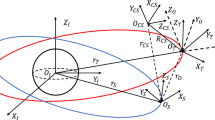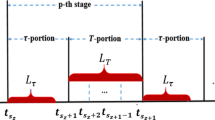Abstract
This paper investigates the robust finite-time attitude tracking control problem for rigid spacecraft considering the modeling uncertainty, external disturbance and actuator saturation. An auxiliary system is proposed to directly compensate for the saturated control input. First, the basic controller is formulated based on the fast nonsingular terminal sliding mode surface (FNTSMS), the fast-TSM-type reaching law and the auxiliary system in the presence of upper bounded external disturbance. Then, when facing system uncertainty which consists of both modeling uncertainty and external disturbance and has upper bounded first derivative, the extended state observer (ESO) is associated with the first controller to improve the robustness of control system. Furthermore, to handle more general system uncertainty which is upper bounded by a polynomial function of the closed-loop system states, a continuous adaptive controller is designed to compensate for the total system uncertainty on line. The proposed controllers are able to deal with system uncertainty, input singularity and actuator saturation, while simultaneously providing fast finite-time convergence speed for the control system. And the problems of complex parameters selection process and repeated differentiations of nonlinear functions can be avoided. Rigorous stability analyses are given via the Lyapunov stability theory and digital simulations are conducted to illustrate the effectiveness of the proposed controllers.
Similar content being viewed by others
References
W. C. Luo, Y. C. Chu, and K. V. Ling, “H-infinity inverse optimal attitude-tracking control of rigid spacecraft,” Journal of Guidance Control & Dynamics, vol. 28, no. 3, pp. 481–494, 2005.
J. R. Forbes, “Passivity-based attitude control on the special orthogonal group of rigid-body rotations,” Journal of Guidance Control & Dynamics, vol. 36, no. 6, pp. 1596–1605, 2013. [click]
S. Sheng and C. Sun, “An adaptive attitude tracking control approach for an unmanned helicopter with parametric uncertainties and measurement noises,” International Journal of Control, Automation and Systems, vol. 14, no. 1, pp. 217–228, 2016. [click]
R. Kristiansen, P. J. Nicklasson, and J. T. Gravdahl, “Satellite attitude tracking by quaternion-based backstepping,” IEEE Transactions on Control Systems Technology, vol. 17, no. 1, pp. 227–232, 2009. [click]
Y. J. Liu and S. Tong, “Optimal control-based adaptive NN design for a class of nonlinear discrete-time block triangular systems,” IEEE Transactions on Cybernetics, vol. 46, no. 11, pp. 2670–2680, 2016. [click]
J. K. Lee, Y. H. Choi, and B. P. Jin, “Sliding mode tracking control of mobile robots with approach angle in Cartesian coordinates,” International Journal of Control, Automation and Systems, vol. 13, no. 3, pp. 718–724, 2015. [click]
Y. J. Liu and S. Tong, “Barrier Lyapunov functions for Nussbaum gain adaptive control of full state constrained nonlinear systems,” Automatica, vol. 76, pp. 143–152, 2017.
S. T. Venkataraman and S. Gulati, “Control of nonlinear systems using terminal sliding modes,” American Control Conference, vol. 115, no. 3, pp. 891–893, 2009.
Y. Tang, “Terminal sliding mode control for rigid robots,” Automatica, vol. 34, no. 1, pp. 51–56, 1998.
E. Jin and Z. Sun, “Robust controllers design with finite time convergence for rigid spacecraft attitude tracking control,” Aerospace Science & Technology, vol. 12, no. 4, pp. 324–330, 2008.
S. Yu, X. Yu, B. Shirinzadeh, and Z. Man, “Continuous finite time control for robotic manipulators with terminal sliding mode,” Automatica, vol. 41, no. 11, pp. 1957–1964, 2005. [click]
K. Lu and Y. Xia, “Finite-time fault-tolerant control for rigid spacecraft with actuator saturations,” IET Control Theory & Applications, vol. 7, no. 11, pp. 1529–1539, 2013. [click]
P. M. Tiwari, S. Janardhanan, and M. U. Nabi, “A finitetime convergent continuous time sliding mode controller for spacecraft attitude control,” International Workshop on Variable Structure Systems, pp. 399–403, 2010.
S. Wu, G. Radice, Y. Gao, and Z. Sun, “Quaternion-based finite time control for spacecraft attitude tracking,” Acta Astronautica, vol. 69, no. 1-2, pp. 48–58, 2011. [click]
Y. Guo, S. M. Song, and X. H. Li, “Quaternion-based finite-time control for attitude tracking of the spacecraft without unwinding,” International Journal of Control, Automation and Systems, vol. 13, no. 6, pp. 1351–1359, 2015. [click]
C. Pukdeboon and P. Siricharuanun, “Nonsingular terminal sliding mode based finite-time control for spacecraft attitude tracking,” International Journal of Control, Automation and Systems, vol. 12, no. 3, pp. 530–540, 2014. [click]
Q. Hu, B. Li, and J. Qi, “Disturbance observer based finitetime attitude control for rigid spacecraft under input saturation,” Aerospace Science & Technology, vol. 39, pp. 13–21, 2014.
K. Lu, Y. Xia, and M. Fu, “Controller design for rigid spacecraft attitude tracking with actuator saturation,” Information Sciences, vol. 220, no. 220, pp. 343–366, 2013.
Z. Zhu, Y. Xia, and M. Fu, “Attitude stabilization of rigid spacecraft with finite-time convergence,” International Journal of Robust & Nonlinear Control, vol. 21, no. 6, pp. 686–702, 2011.
Z. Song, H. Li, and K. Sun, “Finite-time control for nonlinear spacecraft attitude based on terminal sliding mode technique,” ISA Transactions, vol. 53, no. 1, pp. 117–124, 2014.
K. Lu and Y. Xia, “Adaptive attitude tracking control for rigid spacecraft with finite-time convergence,” Automatica, vol. 49, no. 12, pp. 3591–3599, 2013. [click]
A. H. J. D. Ruiter, “Adaptive spacecraft attitude control with actuator saturation,” Journal of Guidance Control & Dynamics, vol. 33, no. 5, pp. 1692–1696, 2012. [click]
Y. J. Liu, S. Tong, D. J. Li and Y. Gao, “Fuzzy adaptive control with state observer for a Class of nonlinear discretetime systems with input constraint,” IEEE Transactions on Fuzzy Systems, vol. 24, no. 5, pp. 1147–1158, 2015. [click]
L. Wang, T. Chai, and L. Zhai, “Neural-network-based terminal sliding mode control of robotic manipulators including actuator dynamics,” IEEE Transactions on Industrial Electronics, vol. 56, no. 9, pp. 3296–3304, 2009. [click]
A. M. Zou, K. D. Kumar, Z. G. Hou, and X. Liu, “Finitetime attitude tracking control for spacecraft using terminal sliding mode and Chebyshev neural network,” IEEE Transactions on Systems Man & Cybernetics, Part B, Cybernetics, vol. 41, no. 4, pp. 950–963, 2011.
Y. J. Liu, S. Tong, C. L. Chen and D. J. Li, “Neural controller design based adaptive control for nonlinear MIMO systems with unknown hysteresis inputs,” IEEE Transactions on Cybernetics, vol. 46, no. 1, pp. 9–19, 2016.
C. L. Chen, G. X. Wen, Y. J. Liu, and Z. Liu, “Observerbased adaptive backstepping consensus tracking control for high order nonlinear semi-strict-feedback multiagent systems,” IEEE Transactions on Cybernetics, vol. 46, no. 7, pp. 1591–1601, 2016.
C. L. P. Chen, Y. J. Liu, and G. X. Wen, “Fuzzy neural network based adaptive control for a class of uncertain nonlinear stochastic systems,” IEEE Transactions on Cybernetics, vol. 44, no. 5, pp. 583–593, 2014. [click]
G. X. Wen, C. L. P. Chen, Y. J. Liu, and Z. Liu, “Neuralnetwork-based adaptive leader-following consensus control for second-order non-linear multi-agent systems,” IET Control Theory and Applications, vol. 9, no. 13, pp. 1927–1934, 2015. [click]
J. D. Boskovic, S. M. Li, and R. K. Mehra, “Robust tracking control design for spacecraft under control input saturation,” Journal of Guidance Control & Dynamics, vol. 27, no. 4, pp. 627–633, 2004. [click]
R. J. Wallsgrove and M. R. Akella, “Globally stabilizing saturated attitude control in the presence of bounded unknown disturbances,” Journal of Guidance Control & Dynamics, vol. 28, no. 5, pp. 957–963, 2005. [click]
M. R. Akella, A. Valdivia, and G. R. Kotamraju, “Velocityfree attitude controllers subject to actuator magnitude and rate saturations,” Journal of Guidance Control & Dynamics, vol. 28, no. 4, pp. 659–666, 2005. [click]
D. Bustan, N. Pariz, and S. K. Sani, “Robust fault-tolerant tracking control design for spacecraft under control input saturation,” ISA Transactions, vol. 53, no. 4, pp. 1073–1080, 2014. [click]
A. M. Zou, K. D. Kumar, and A. H. J. D. Ruiter, “Robust attitude tracking control of spacecraft under control input magnitude and rate saturations,” International Journal of Robust & Nonlinear Control, no. 26, pp. 799–815, 2016.
J. Hu and H. Zhang, “A simple saturated control framework for spacecraft with bounded disturbances,” International Journal of Robust & Nonlinear Control, vol. 26, no. 3, pp. 367–384, 2015.
Haibo Du and Shihua Li. “Finite-time attitude stabilization for a spacecraft using homogeneous method,” Journal of Guidance Control & Dynamics, vol. 35, no. 3, pp. 740–748, 2012. [click]
Q. Hu, J. Zhang, and M. I. Friswell, “Finite-time coordinated attitude control for spacecraft formation flying under input saturation,” Journal of Dynamic Systems Measurement & Control, vol. 137, no. 6, 2015.
B. Xiao, Q. Hu, and M. I. Friswell, “Active fault-tolerant attitude control for flexible spacecraft with loss of actuator effectiveness,” International Journal of Adaptive Control & Signal Processing, vol. 27, no. 11, pp. 925–943, 2013. [click]
J. Ma, P. Li, L. Geng, and Z. Zheng, “Adaptive finite-time attitude tracking control of an uncertain spacecraft with input saturation,” IEEE Conference on Control Application (CAA), Part of 2015 IEEE Multi-Conference on Systems and Control, Sydney, Australia, pp. 930–935, 2015.
M. D. Shuster, “A survey of attitude representations,” The journal of the Astronautical Sciences, vol. 41, no. 4, pp. 439–517, 1993.
D. J. Zhao and D. G. Yang, “Model-free control of quadrotor vehicle via finite-time convergent extended state observer,” International Journal of Control, Automation and Systems, vol. 14, no. 1, pp. 242–254, 2016. [click]
W. C. Cai, X. H. Liao, and Y. D. Song, “Indirect robust adaptive fault-tolerant control for attitude tracking of spacecraft,” Journal of Guidance Control & Dynamics, vol. 31, no. 5, pp. 1456–1463, 2008. [click]
Author information
Authors and Affiliations
Corresponding author
Additional information
Recommended by Associate Editor Ohmin Kwon under the direction of Editor Jessie (Ju H.) Park. This paper was supported by the National Natural Science Foundation of China (61174037) and the Foundation for Innovative Research Groups of the National Natural Science Foundation of China (61021002).
Hai-Tao Chen received his B.S. and M.S. degrees in School of Automation from USTB. Currently, he is a Ph.D. student in the School of Astronautics at Harbin Institute of Technology. His main research interests include spacecraft attitude control, sliding mode control and adaptive control.
Shen-Min Song received his Ph.D. degree in Control Theory and Application from Harbin Institute of Technology in 1996. He carried out postdoctoral research at Tokyo University from 2000 to 2002. He is currently a professor in the School of Astronautics at Harbin Institute of Technology. His main research interests include spacecraft guidance and control, intelligent control, and nonlinear theory and application.
Zhi-Bin Zhu received his Ph.D. degree in Control Science and Engineering from Harbin Institute of Technology in 2009. He is currently a senior engineer at Beijing Institute of Control Engineering. His main research interests include nonlinear control, spacecraft guidance and control, space robot on-orbit control.
Rights and permissions
About this article
Cite this article
Chen, HT., Song, SM. & Zhu, ZB. Robust Finite-time Attitude Tracking Control of Rigid Spacecraft Under Actuator Saturation. Int. J. Control Autom. Syst. 16, 1–15 (2018). https://doi.org/10.1007/s12555-016-0768-1
Received:
Revised:
Accepted:
Published:
Issue Date:
DOI: https://doi.org/10.1007/s12555-016-0768-1




